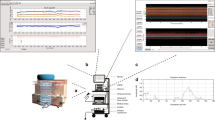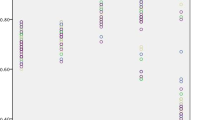Abstract
We want to illustrate the difficulty of establishing a brain death diagnosis in newborn children and how an easy and useful tool, the transcranial Doppler ultrasonography, can leave an unexpected result that complicates the process despite the rest of the diagnostic tests. We describe a 36-week gestation newborn male who was diagnosed of brain death after asphyxiated and offered for donation. After initial stabilization at admission, we established brain death diagnosis by checking and meeting every criterion. The donation process was complicated because of persistent blood flow on transcranial Doppler ultrasonography. Transcranial Doppler ultrasonography is a very useful method to assess cerebral blood flow. However, caution and individualization are needed when interpreting this complementary exam, especially in highly conflictive situations like brain death diagnosis.
This is a preview of subscription content, access via your institution
Access options
Subscribe to this journal
Receive 12 print issues and online access
$259.00 per year
only $21.58 per issue
Buy this article
- Purchase on Springer Link
- Instant access to full article PDF
Prices may be subject to local taxes which are calculated during checkout

Similar content being viewed by others
References
Boletín oficial del estado. Real Decreto 2070/1999, de 30 de diciembre, por el que se regulan las actividades de obtención y utilización clínica de órganos humanos y la coordinación territorial en materia de donación y trasplante de órganos y tejidos. BOE 3/2000 de 4-1-2000, pp 179–90.
Haupt WF, Rudolf J . European brain death codes: a comparison of national guidelines. J Neurol 1999; 246: 432–437.
Monteiro LM, Bollen CW, van Huffelen AC, Ackerstaff RG, Jansen NJ, van Vught AJ . Transcranial Doppler ultrasonography to confirm brain death: a meta-analysis. Intensive Care Med 2006; 32: 1937–1944.
Wijdicks EFM . The diagnosis of brain death. N Engl J Med. 2001; 344: 1215–1221.
Ashwal S, Serna-Fonseca T . Brain death in infants and children. Crit Care Nurse 2006; 26: 117–118.
Shemie D. . Brain death In: Wheeler DS et al. (eds). Resuscitation and Stabilization of the Critically Ill Child. Springer-Verlag: London Limited, 2009, pp 141–150.
Segura T, Calleja S, Irimia P, Tembl JI . Recommendations for the use of transcranial Doppler ultrasonography to determine the existence of cerebral circulatory arrest as diagnostic support for brain death. Rev Neurosci 2009; 20: 251–259.
Ducrocq X, Hassler W, Moritake K, Newell D, Von Reutern GM, Shiogai T et al. Consensus opinion on diagnosis of cerebral circulatory arrest using Doppler-sonography. Task Force Group on cerebral death of the Neurosonology Research Group of the World Federation of Neurology. J Neurol Sci 1998; 159: 145–150.
Hadani M, Gruk B, Ram Z, Knoller N, Spiegelman R, Segal E . Application of transcranial Doppler ultrasonography for the diagnosis of brain death. Intensive Care Med 1999; 25: 98–101.
De Freitas GR, Andre C . Sensitivity of transcranial Doppler for confirming brain death: a prospective study of 270 cases. Acta Neurol Scand 2006; 113: 426–432.
Dosemeci L, Dora B, Yilmaz M, Cengiz M, Balkan S, Ramazanoglu A . Utility of transcranial doppler ultrasonography for confirmatory diagnosis of brain death: two sides of the coin. Transplantation 2004; 77: 71–75.
Vicenzini E, Pulitano P, Cicchetti R, Randi F, Papov P, Spadetta G et al. Transcranial Doppler for brain death in infants: the role of the fontanelles. Eur Neurol 2010; 63: 164–169.
Author information
Authors and Affiliations
Corresponding author
Ethics declarations
Competing interests
The authors declare no conflict of interest.
Rights and permissions
About this article
Cite this article
Mata-Zubillaga, D., Oulego-Erroz, I. Persistent cerebral blood flow by transcranial Doppler ultrasonography in an asphyxiated newborn meeting brain death diagnosis: case report and review of the literature. J Perinatol 32, 473–475 (2012). https://doi.org/10.1038/jp.2011.147
Received:
Revised:
Accepted:
Published:
Issue Date:
DOI: https://doi.org/10.1038/jp.2011.147
Keywords
This article is cited by
-
The role of cervical color Doppler ultrasound in the diagnosis of brain death
Neuroradiology (2019)
-
Gestion du donneur d’organes pédiatrique
Réanimation (2013)



